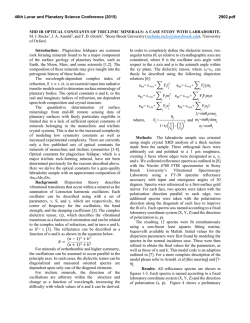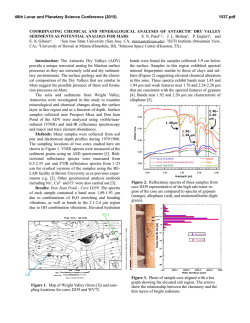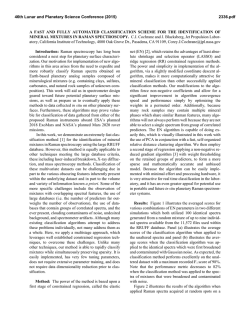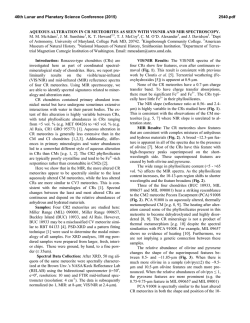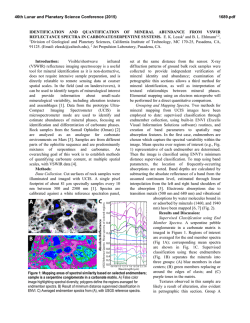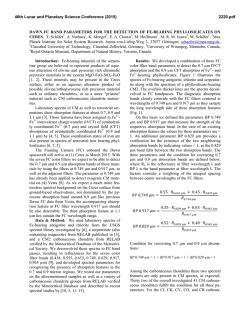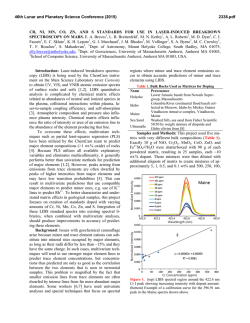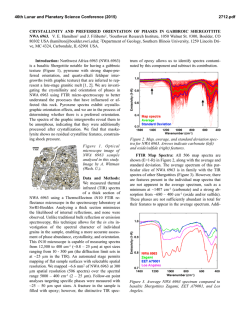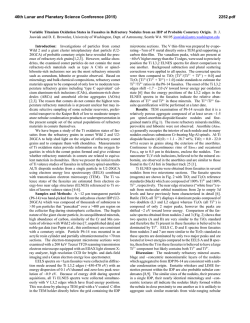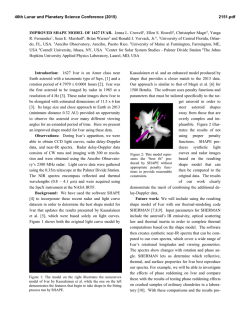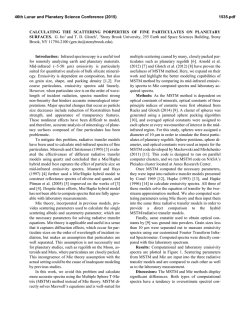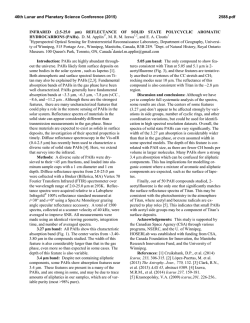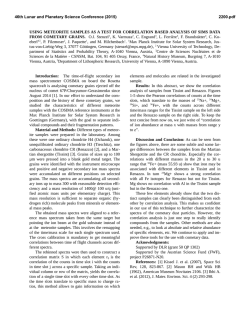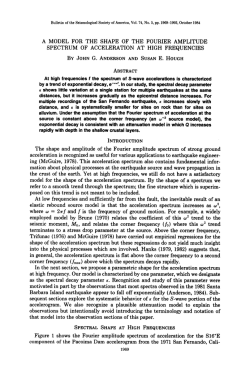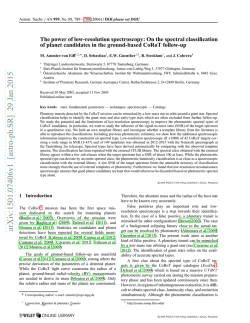
Comparative Study of CK Carbonaceous Chondrites and Asteroids
46th Lunar and Planetary Science Conference (2015) 1106.pdf COMPARATIVE STUDY OF CK CARBONACEOUS CHONDRITES AND ASTEROIDS REFLECTANCE SPECTRA BETWEEN 0.3 AND 2.6 µm. C. E. Moyano-Cambero1 and J. M. Trigo-Rodríguez1, 1 Meteorites, Minor Bodies and Planetary Science Group, Institute of Space Sciences (CSIC-IEEC), Campus UAB, Fac. Sciences, C5-p2, 08193 Bellaterra (Barcelona), Spain ([email protected], [email protected]), Introduction: Following previous studies at the Institute of Space Sciences [1], here we use meteorite reflectances in the ultraviolet to near-infrared range (or UV-NIR, 0.3 to 2.6 µm) to compare them with the mean spectra of several asteroid classes. The relationship between several carbonaceous chondrite (hereafter CCs) groups and asteroid classes remains controversial. Most of this km-sized objects are pieces of larger bodies, that broke after collisions or were disrupted by tidal forces during a quite early epoch in their formation stage [2]. CCs are therefore samples from these undifferentiated bodies, i.e., small enough to avoid melting of their materials due to heating from radioactive decay. After complex evolutionary histories along the eons, they arrive to Earth thanks to dynamic resonances [3]. Most chondrite groups show a decrease in their overall reflectivity in the UV-NIR range due to the matrix, which contains darkened materials [4,5]. This is why the parent bodies of these meteorites are some of the darkest objects of our Solar System. Figure 1. Mean CK petrologic types spectra. Mean CK4 includes CK4/5; Mean CK5 includes CK4/5 and CK5/6; Mean CK6 includes CK5/6. The error bars are 1σ. Mean CK4 is the mean of 14 spectra of 5 different meteorites. Mean CK5 is the mean of 11 spectra of 6 different meteorites. Mean CK6 is the mean of 11 spectra of 2 different meteorites. The spectra are vertically shifted to avoid superposition. We focus this abstract in the CK group. Those are highly oxidized meteorites, dominated by olivine (Fa 29-33), with a matrix similar in composition to CVs and COs, but more highly metamorphosed [5]. Although they have been tentatively related before to the Eos asteroid family [6], and therefore to K-type asteroids [7], no definitive correlation has been stablished between them. Technical procedure: In this study we use several CK carbonaceous chondrites spectra, obtained from the RELAB database (Table 1). Through the Bus-DeMeo Taxonomy Classification tool we compared those spectra with the mean spectra for every asteroidal type. We complemented the automatic comparison performed by the software with a proper visual comparison, which allows to discriminate whenever the software provides more than one asteroidal type as possible matches for a single meteorite spectrum. Before comparing the spectra we normalized them all to a value of 1 at 0.55 µm, and we deliverately left the discussion about the albedo for a future more extended study, so only the shape of the spectra is actually used here. Results and discussion: Besides from the specific characteristics of each sample, some differences between them come from the measuring conditions [5]. In order to try to appreciate the variations produced in CK spectra due to the degree of metamorphism, we calculated the mean spectrum for each petrologic type (Fig. 1). The meteorites used on this study include petrologic types from 4 to 6 (some of them are 4/5 or 5/6, being either one or other option), implying a medium to high degree of metamorphism. In fact, CKs could be the metamorphic evolution of CVs [8,9]. Meteorite Type Weathering Find/Fall ALH 85002 CK4 A 1985 (found) DAV 92300 CK4 A/B 1992 (found) EET 83311 CK5 A/B 1983 (found) EET 87507 CK5 B 1987 (found) EET 87526 CK5 Be 1987 (found) EET 87860 CK5/6 A/B 1987 (found) EET 92002 CK5 A/Be 1992 (found) Karoonda CK4 - 1930 (fall) LEW 87009 CK6 Ae 1987 (found) PCA 91470 CK4 A/B 1991 (found) Y-693 CK4/5 - 1969 (found) Table 1. CK chondrites used in this study. As it is common for CK chondrites, the most remarkable feature is the absorption band at approxi- 46th Lunar and Planetary Science Conference (2015) mately 1.05 µm, consistent with the presence of a high content in forsterite [5]. In fact, the Mg-rich olivine is dominant in the spectrum of CKs, although they tend to be darker and with a bluer slope. That difference has been attributed to darkened silicates induced by shock, and containing grains of magnetite and pentlandite [10]. The contribution of other silicates to the spectra is much less remarkable. The band between 1.80-2.08 µm for low-Ca pyroxenes is not appreciable in any of the three mean spectra, but a faint band can be seen between 2.3 and 2.35 µm in the mean CK5 and CK6 spectra, which could be related to the 1.90-2.38 µm from high-Ca pyroxenes, although it seems to be inconsistent with the general abundance of these two types of minerals described for CKs in previous studies [5]. Figure 2. Mean CK spectra. The error bars are 1σ. It is the mean of 32 spectra of 11 different meteorites. The mean asteroid family spectra were obtained from the Bus-DeMeo Taxonomy Classification tool Apart from the already mentioned, there are additional differences between the mean spectra of different petrologic types. First of all, the error bars are increasingly wider from type 4 to type 6, implying a higher heterogeneity in the reflective properties related with the degree of metamorphism. The ‘hill’ centered at ~ 0.6 µm seems to be wider and softer in CK4 chondrites, while the strength of the slope between 0.3 and 0.5 µm apparently increases with the petrologic type. As mentioned in previous studies, the 1.05 µm forsterite band is more remarkable in CK6 chondrites [5], and so is the red slope from 1 to 1.5-1.6 µm. In the three spectra the slope after 1.6 µm is slightly blue, but is more noticeable in the mean CK5 spectrum than in the mean CK4 spectrum, which is almost flat after 1.1 µm. The Bus-DeMeo Taxonomy Classification tool allowed us to relate those CK UV-NIR spectra with the asteroid types. Most of them are classified as K-type 1106.pdf asteroids due to their shape, or as B-type asteroids due to their bluish slope. Xe, Xk, Xc, Xn, C and Ch-types were other options suggested by the software, but most of them can be easily discarded by direct visual comparison. However, and despite of the differences, we decided to take Cg-type asteroids into consideration. In Fig. 3 we show the mean spectrum of CK meteorites calculated using all the CK UV-NIR spectra we had available, compared to the B, K and Cg-type asteroids mean spectra. The shape of the CK spectrum is very similar to the K-type spectrum, but the first is much bluer. However is it obviously different to B-type asteroids. The region between 0.5 and 0.8 µm shows some more consistency with Cg than with K-type asteroids, but not beyond this point. Conclusions and future studies: With this study we propose that a progressive spectral variation can be established in CK chondrites for increasing petrologic types. Also, we consider that a mixture of K and Cgtype asteroids, darkened and bluened probably by further collisional processing, could be a better match for CK meteorites. Future work on this direction will include spectra in the IR region and Raman spectroscopy. Acknowledgements: JMTR, and CEMC acknowledge finantial support from the Spanish Ministry (project AYA2011-26522). This research utilizes spectra acquired with the NASA RELAB facility at Brown University. Asteroidal taxonomic type results presented in this work were determined using a BusDeMeo Taxonomy Classification Web tool by Stephen M. Slivan, developed at MIT with the support of National Science Foundation Grant 0506716 and NASA Grant NAG5-12355. References: [1] Trigo-Rodríguez J.M. et al. (2014) MNRAS 437, 227-240. [2] Chapman C.R. et al. (1975) Icarus 25, 104-130. [3] DeMeo F. et al. (2009) Icarus 202, 160-180. [4] Cloutis E.A. et al. (2011) Icarus 212, 180-209. [5] Cloutis E.A. et al. (2012) Icarus 221, 911-924. [6] Mothé-Diniz T. et al. (2008) Icarus 195, 277-294. [7] Bell J.F. (1988) Meteoritics 23, 256-257. [8] Kallemeyn G.W. et al. (1991) Geochim. Cosmochim. Acta 55, 881-892. [9] Greenwood R.C. et al. (2003) Meteorit. Planet. Sci. 38, A96 (abstract) [10] Brearley A.J. & Jones R.H. (1998) In: Papike, J.J. (Ed.), Planetary Materials, Reviews in Mineralogy, 36.
© Copyright 2026
